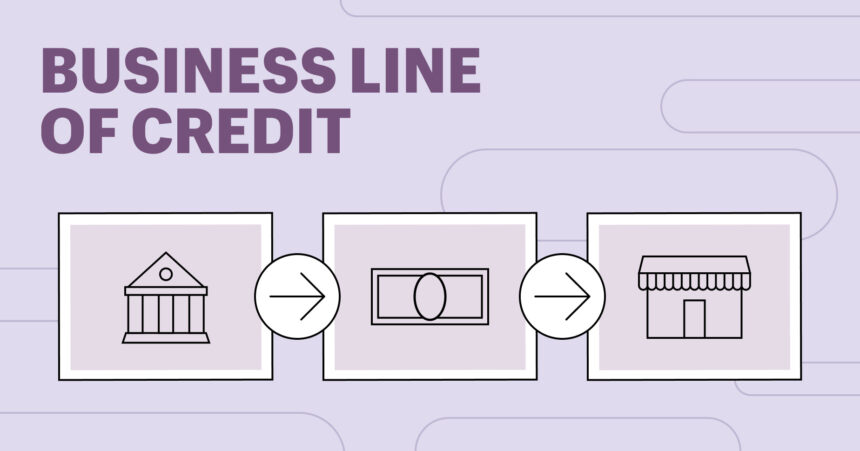Owning a business means being ready for anything, whether it’s investing in a new project or dealing with financial downturns.
For small expenses, using savings or a business credit card may suffice. However, a business line of credit can provide a higher credit limit and lower interest rates than credit cards, giving you more flexibility in how you spend.
You’ll need to apply and get approved as with a business loan, but you won’t have to borrow money or pay interest until you use your account.
What is a business line of credit?
A business line of credit (LOC) gives you the option to take out a loan, known as a draw, but doesn’t require you to take out a loan when you apply.
If approved, your account will have a maximum credit limit. You can then take out a single loan, or a series of loans, against your credit limit and will only pay interest on the amount you borrow.
How does a business line of credit work?
You can apply for either a secured or unsecured line of credit. They generally work the same way once your account is open, but there is an important difference:
- Secured business line of credit. A secured credit line requires collateral, such as business equipment, accounts receivable, or a blanket lien on your business. The lender can take or sell the collateral to cover any unpaid debts. Business owners may also need to sign a personal guarantee, which means they promise to repay the loan if the business doesn’t.
- Unsecured business line of credit. Unsecured lines of credit don’t require collateral. Instead, your approval and terms will depend on your business’s creditworthiness, which may include its credit history, credit score, and financial position. The owner’s creditworthiness is also often a factor for small businesses.
It might be easier to qualify for a secured LOC, and you may receive more favorable terms, but you risk losing your collateral. Creditors can sue you if you default on an unsecured LOC, but they won’t be able to immediately claim your business assets.
Where to get a business line of credit
You can secure a business line of credit online, in person, or over the phone through many different lenders. Here are the top three sources:
Online lenders
Online lenders offer lines of credit for newer businesses or business owners who may have shorter business histories, lower credit scores, and lower business revenue.
Shopify Line of Credit, for example, is ideal for merchants looking for capital injection to fuel business growth and optimize cash flow.
Eligibility is based on business performance, not credit score. If your business qualifies, you’ll receive a customized financing offer via email and in your Shopify admin. Once you apply and get approved, the funds should appear in your linked bank account in as quick as two business days and ready to use.
Online lenders typically have more flexible requirements, streamlined application processes, and fewer fees. While these lenders tend to fund loans faster than banks, they may charge higher interest rates than banks and credit unions.
Banks and credit unions
Banks and credit unions offer business lines of credit with competitive interest rates. However, they have stringent qualification processes and may require you to put down physical collateral or provide a guarantor.
To qualify for loans through these institutions, you’ll likely need a high credit score, several years in business, and substantial annual revenue.
Small Business Administration
The U.S. Small Business Administration (SBA) provides business lines of credit of up to $5 million through itsCAPLines program. The SBA itself doesn’t dole out the funds, but partners with approved SBA lenders.
It’s ideal for business owners who need short-term working capital to overcome temporary cash flow shortages or weather a crisis.
To qualify for an SBA line of credit, you must meetSBA’s definition of small business, own equity in the business, and exhibit the ability to repay the loan. Then, check if your bank or credit union is authorized to offer SBA-backed funding before submitting your application.
How to get a business line of credit
You know how much funding you need. The next step is to research and apply for a business line of credit. Let’s look at the steps for how to get one.
1. Determine how you’ll use the money
Businesses typically use lines of credit for short-term needs, such as inventory or unforeseen expenses, or when they need to manage cash flow.
If you run a diner and one of your ovens breaks down unexpectedly, for instance. You could use cash from a line of credit in the short term to fix it quickly, so you don’t lose out on too much business.
Depending on your needs, you can either apply for a revolving line of credit or a non-revolving line:
- Revolving lines of credit. Let you repeatedly take out and repay loans without applying for a new LOC—a credit card is a type of revolving credit line. Most lines of credit are revolving, so the amount of money you can borrow replenishes as you repay previous draws.
- Non-revolving lines of credit. You can still choose when and how much to borrow, but your credit limit determines the total amount you can borrow.
2. Review your business credentials
Lenders can set the requirements for their lines of credit, but there are a few categories and factors that lenders tend to consider:
- A business entity. Some lenders offer business lines of credit to sole proprietors, but others only lend to incorporated businesses.
- Good credit. Your personal credit history and scores, along with your business’s credit score, can also be factors.
- A personal guarantee. If you have a small business or are a sole proprietor, you may need to sign a personal guarantee.
- Revenue. Your business may need to meet minimum monthly or annual revenue requirements, and this can have an impact on your LOC’s credit limit.
- Years in business. Traditional lenders generally require that a business have at least a two-year operating history to qualify for an LOC, but online lenders may offer an LOC to a newer business.
- Your business’s industry and size. Lenders might automatically reject businesses that are part of risky or heavily regulated industries. The size of your business can also play a role in its eligibility.
- A business plan, financial statements, and loan proposal. Lenders may want to review yourbusiness plan,financial statements, and how you plan to use the loan before agreeing to lend you money.
- Collateral. You’ll also need to have collateral to pledge to the lender if you’re applying for a secured LOC.
3. Evaluate lenders
Look into traditional and fintech lenders to see who offers lines of credit and if you’d qualify for them. Try to narrow down your selection to a handful of top picks based on their loan amounts, interest rate ranges, repayment terms, and fees.
4. Submit a line of credit application
Follow the lender’s requirements for submitting your application. You may need to agree to a personal credit check and share copies of documents to verify your information, such as your identification, business licenses,bank statements, financial statements, and tax returns.
5. Receive your line of credit
It can take as little as five minutes to as long as several days for a lender to share their decision on your application. If approved, the lender may require you to provide additional documentation and send you an agreement to sign before issuing a line to draw from. The funds should appear in your bank account in 1-2 business days.
Things to consider when getting a line of credit
Whether this is your first time seeking a line of credit or not, keep these factors in mind when choosing one for your needs:
- Interest rates. An LOC may have a lower interest rate and higher credit limit than business credit cards, which can make it a better option for some short- to medium-term loans. However, the rate you receive will depend on several factors, including time in business, credit history, and annual revenue.
- Funding amount. Most traditional and online lenders typically advertise lines of credit between $5,000 and $500,000. But they’ll evaluate your risk level before deciding how much money to make available to you just to be sure you can pay it back.
- Additional fees. Before opening a business LOC, review the account’s fees and terms closely. Although you’ll only pay interest on the money you borrow, some lenders impose monthly or annual fees to keep your account open. Additionally, you could have to pay a draw fee on each loan you take or an inactivity fee if you don’t use the credit line.
- Repayment term. A business line of credit may require daily, weekly, or monthly payments. Check your budget and cash flow to ensure you can afford to pay off the credit line before getting one.
- Timeline of funding. Research different lenders’ application processes and funding speed. Traditional lenders, like banks and credit unions, might take up to two weeks or longer, while online lenders typically make credit decisions within minutes or a few days.Shopify Line of Credit, for example, allows eligible merchants to apply for financing online in a few clicks. If approved, the funds are deposited in their connected bank accounts within two business days.
- Early repayment fees. Paying off or closing your account early might even result in prepayment penalties or early termination fees. Review your business loan agreement to see if your line of credit has such fees and business loan prepayment penalties.
- Lender reputation. Read online reviews or talk to other business owners to get a sense of what it may be like to work with the lenders you’re considering. Be wary of lenders offering “guaranteed approvals” or making similar too-good-to-be-true promises.
Is a line of credit right for your business?
A business line of credit is useful if you want to access a revolving source of funding for short-term working capital needs—especially in uncertain times, like when you might struggle to predict expenses and revenue. Keep in mind that a line of credit is more likely to have variable interest rates, which could increase if you miss a payment. You could also pay more depending on the choice of lender.
If you’re borrowing to cover consistent gaps in cash flow, consider invoice financing. For large purchases, like vehicles, equipment, or real estate, a business term loan is typically more affordable and more likely to have longer repayment terms.
Ultimately, the best choice for your business will depend on how much money you need, what you’ll use it for, and how much you can qualify for.
Business line of credit FAQ
What is a business line of credit for?
A business line of credit can be helpful if you need money for working capital and emergency expenses. You may also want to use an LOC to finance projects that require progress payments, such as a marketing campaign or new construction.
What’s the difference between a line of credit and a credit card?
A line of credit is different from a credit card. A line of credit is a flexible loan from a bank or financial institution that allows you to borrow up to a certain limit, repay it, and borrow again as needed. With credit cards, you can buy stuff, make payments, get rewards, and protect yourself from fraud.
How soon do you have to pay back a business line of credit?
Repayment time depends on the terms outlined in your loan agreement, but it typically ranges between six months and five years.
Can I use a line of credit to start a business?
Typically, no. Most lenders have minimum credit scores, business history, and revenue requirements in their loan applications. As such, your business will need to be at least six to 12 months old with several months’ worth of revenue history to qualify. Check with each lender to see if they offer a startup business line of credit.
What is the normal rate for a business line of credit?
The average rates for new business lines of credit currently stand between 7% to 21%, depending on the type of line. The rate you get will vary depending on factors, like your lender, credit history, time in business, and financial history.
Does applying for a business line of credit hurt your credit score?
In most cases, applying for a business line of credit won’t directly impact your credit score. Most lenders will require you to have at least fair credit, but it’s possible to find a lender that offers a business line of credit to business owners with bad credit.
Can you pay off a business line of credit early?
shopify.com/lending.
Available in select countries. Offers to apply do not guarantee financing. All financing through Shopify Lending, including Shopify Capital and Line of Credit products, is issued by WebBank in the United States.







